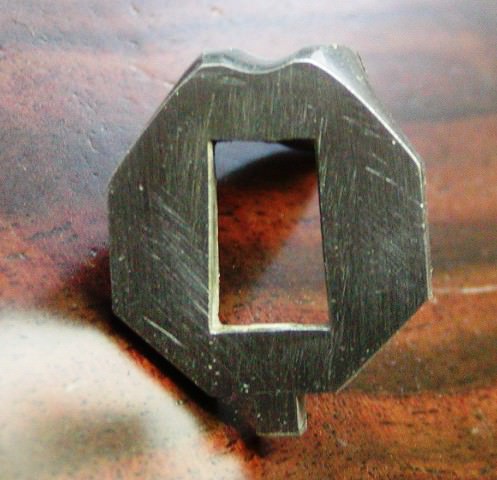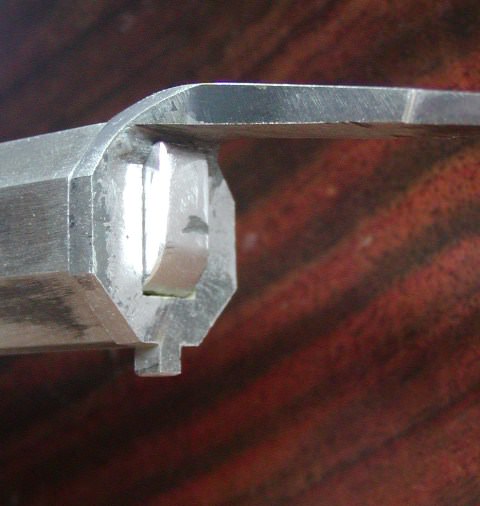Skychief
69 Cal.
I've had a custom built half stocked 45 caliber for several years. It has a hooked breech with two keys through the forestock.
Love the gun....fits great, holds nice, pretty wood, etc. The problem with it until today's range session has been a lack of accuracy. The rifle would only give 60 yard groups in the 3-4" neighborhood. Double those measurements at 100. No amount of tinkering with loads would make it shoot tighter than that.
Today I tried something that got it shooting as good as I could hold it and as well as I can use its sights. One inch groups from a shoddy rest at 60 yards became monotonous. While I had on hand Goex 2f and 3f, as well as a pound of Swiss 3f, I only used the Goex 2f as I was completely satisfied with the groups the rifle finally delivered.
I used 70 and 45 grain loads. After finding the rifle shooting well at 60, I stretched it out to 100 yards and hit to point of aim there as well.
The big "fix" today involved a pure lead roundball, a hammer, and a pocket knife.
I hammered the ball flat into a sheet of lead. I would guess the thickness of a lot of pillow ticking. Maybe a hair thicker.
Then cut two pieces of the lead to fit between the end of the breech (on either side of the hook), and the receiving tang.
When putting the barrel back into the stock to receive the two keys, I could feel a bit of resistance as the breech mated with the tang, squishing the lead shims a bit. The rifle sure felt snug as I drove the keys home.
After this bit of "shade tree mechanic-ing", the fine accuracy arrived as described above!
So simple, so easy. I wish I'd done this years ago as the rifle is a completely different animal now.
As rain moved in, I abbreviated the session and cleaned her up on the porch.
The forecast looks good tomorrow and there's no mowing or other chores to see to, so, I might just dirty her up again then.
Wanted to share this. Maybe it'll help others with hook breeched rifles that don't seem to be giving their all. :thumbsup:
Best regards, Skychief
Love the gun....fits great, holds nice, pretty wood, etc. The problem with it until today's range session has been a lack of accuracy. The rifle would only give 60 yard groups in the 3-4" neighborhood. Double those measurements at 100. No amount of tinkering with loads would make it shoot tighter than that.
Today I tried something that got it shooting as good as I could hold it and as well as I can use its sights. One inch groups from a shoddy rest at 60 yards became monotonous. While I had on hand Goex 2f and 3f, as well as a pound of Swiss 3f, I only used the Goex 2f as I was completely satisfied with the groups the rifle finally delivered.
I used 70 and 45 grain loads. After finding the rifle shooting well at 60, I stretched it out to 100 yards and hit to point of aim there as well.
The big "fix" today involved a pure lead roundball, a hammer, and a pocket knife.
I hammered the ball flat into a sheet of lead. I would guess the thickness of a lot of pillow ticking. Maybe a hair thicker.
Then cut two pieces of the lead to fit between the end of the breech (on either side of the hook), and the receiving tang.
When putting the barrel back into the stock to receive the two keys, I could feel a bit of resistance as the breech mated with the tang, squishing the lead shims a bit. The rifle sure felt snug as I drove the keys home.
After this bit of "shade tree mechanic-ing", the fine accuracy arrived as described above!
So simple, so easy. I wish I'd done this years ago as the rifle is a completely different animal now.
As rain moved in, I abbreviated the session and cleaned her up on the porch.
The forecast looks good tomorrow and there's no mowing or other chores to see to, so, I might just dirty her up again then.
Wanted to share this. Maybe it'll help others with hook breeched rifles that don't seem to be giving their all. :thumbsup:
Best regards, Skychief










